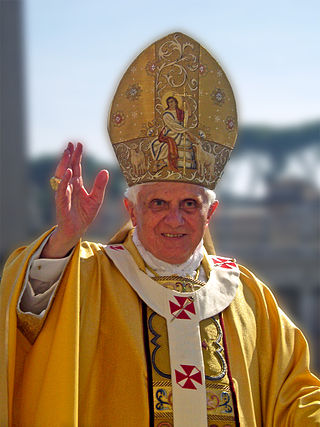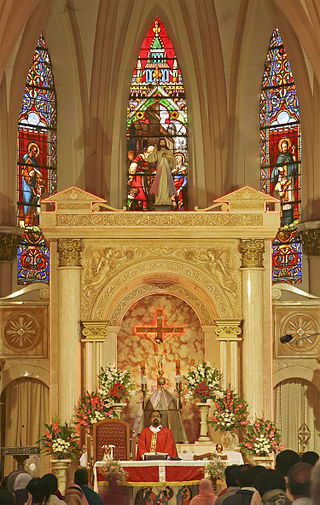
Mass is the main Eucharistic liturgical service in many forms of Western Christianity. The term Mass is commonly used in the Catholic Church, Western Rite Orthodoxy, Old Catholicism, and Independent Catholicism. The term is also used in some Lutheran churches, as well as in some Anglican churches, and on rare occasion by other Protestant churches.

The Mass of Paul VI, also known as the Ordinary Form or Novus Ordo, is currently the most commonly used liturgy in the Catholic Church. It was promulgated by Pope Paul VI in 1969 and its liturgical books were published in 1970; those books were then revised in 1975, they were revised again by Pope John Paul II in 2000, and a third revision was published in 2002.

The Tridentine Mass, also known as the Traditional Latin Mass or the Traditional Rite, is the liturgy in the Roman Missal of the Catholic Church codified in 1570 and published thereafter with amendments up to 1962. Celebrated almost exclusively in Ecclesiastical Latin, it was the most widely used Eucharistic liturgy in the world from its issuance in 1570 until the introduction of the Mass of Paul VI.

Divine Liturgy or Holy Liturgy is the Eucharistic service of the Byzantine Rite, a liturgical rite developed from the Antiochene Rite of Christian liturgy which is that of the Ecumenical Patriarchate of Constantinople. As such, it is used in the Eastern Orthodox, the Greek Catholic Churches, and the Ukrainian Lutheran Church. Although the same term is sometimes applied in English to the Eucharistic service of Armenian Christians, both of the Armenian Apostolic Church and of the Armenian Catholic Church, they use in their own language a term meaning "holy offering" or "holy sacrifice". Other churches also treat "Divine Liturgy" simply as one of many names that can be used, but it is not their normal term.

The kiss of peace is an ancient traditional Christian greeting, also called the holy kiss, and sometimes the "brother kiss", or the "sister kiss". Such greetings signify a wish and blessing that peace be with the recipient, and besides their spontaneous uses they have certain ritualized or formalized uses long established in liturgy. Many denominations use other forms of greeting to serve equivalent purposes; these include handshakes, gestures, and hugs, any of which may be called a sign of peace.

Hans Urs von Balthasar was a Swiss theologian and Catholic priest who is considered an important Catholic theologian of the 20th century. Pope John Paul II announced his choice of Balthasar to become a cardinal, but he died shortly before the consistory. Cardinal Joseph Ratzinger said in his funeral oration for Balthasar that "he is right in what he teaches of the faith" and that he "points the way to the sources of living water".

The Anaphora is the most solemn part of the Eucharistic liturgies, such as the Divine Liturgy or the Mass, which serves as a thanksgiving prayer by virtue of which the offerings of bread and wine are consecrated as the body and blood of Christ. This is the usual name for this part of the Liturgy in Greek-speaking Eastern Christianity. In the Eastern Syriac tradition Qudaša is its equivalent. The corresponding part in western Christian liturgy is nowadays most often called the Eucharistic Prayer. The Roman Rite from the 4th century until after Vatican II had a single such prayer, called the Canon of the Mass.

The Roman Rite is the most common ritual family for performing the ecclesiastical services of the Latin Church, the largest of the sui iuris particular churches that comprise the Catholic Church. The Roman Rite governs rites such as the Roman Mass and the Liturgy of the Hours as well as the manner in which sacraments and blessings are performed.

Romano Guardini was an Italian, naturalized German Catholic priest, philosopher and theologian.
The Liturgical Movement was a 19th-century and 20th-century movement of scholarship for the reform of worship. It began in the Catholic Church and spread to many other Christian churches including the Anglican Communion, Lutheran and some other Protestant churches.
The Paschal mystery is one of the central concepts of Catholic faith relating to the history of salvation. According to the Compendium of the Catechism of the Catholic Church, "The Paschal Mystery of Jesus, which comprises his passion, death, resurrection, and glorification, stands at the center of the Christian faith because God's saving plan was accomplished once for all by the redemptive death of himself as Jesus Christ." The Catechism states that in the liturgy of the Church "it is principally his own Paschal mystery that Christ signifies and makes present."
Louis Bouyer, CO, was a French Catholic priest and former Lutheran minister who was received into the Catholic Church in 1939. During his religious career he was an influential theological thinker, especially in the fields of history, liturgy and spirituality, and as peritus helped shape the vision of the Second Vatican Council. Along with Joseph Cardinal Ratzinger, Hans Urs von Balthasar, and others, he was a co-founder of the international review Communio. He was chosen by the pope to be part of a team to initiate the International Theological Commission in 1969.
Mediator Dei is a papal encyclical issued by Pope Pius XII on 20 November 1947. It was the first encyclical devoted entirely to liturgy.

The Pope Benedict XVI bibliography contains a list of works by Pope Benedict XVI.

The Ratzinger Report is a 1985 book consisting of a series of interviews collected over several days given by Joseph Cardinal Ratzinger to the Italian journalist Vittorio Messori. The book focuses on the state of the Roman Catholic Church after the Second Vatican Council. The book is very critical of the "hermeneutic of rupture" associated with the liberal "spirit of Vatican II" within the Church. It has often been reread in the context of the papacy of Pope Benedict XVI in order to better understand the mind and the thinking of the former pontiff.

Ad orientem, meaning "to the east" in Ecclesiastical Latin, is a phrase used to describe the eastward orientation of Christian prayer and Christian worship, comprising the preposition ad (toward) and oriens, participle of orior.

Versus populum is the liturgical stance of a priest who, while celebrating Mass, faces the people from the other side of the altar. The opposite stance, that of a priest facing in the same direction as the people, is today called ad orientem or ad apsidem.

Introduction to Christianity is a 1968 book written by Joseph Ratzinger. Considered one of his most important and widely read books, it presents a "narrative Christology" that demonstrates the place for faith is in the Church. The book offers a "remarkable elucidation of the Apostle's Creed" and gives an "excellent, modern interpretation of the foundations of Christianity".
The Rite of Braga is a Catholic liturgical rite associated with the Archdiocese of Braga in Portugal.

The term people's altar was used to refer to the free-standing altar in Catholic churches, where the priest celebrates the Eucharistic part of Holy Mass turned towards the faithful (versus populum), as opposed to ad orientem where the people and the priest face the altar together. That is so that those who join in the celebration can face each other, and so experience themselves as gathered around the altar. The usage of the term has diminished significantly in recent years, and is no longer commonplace in Catholic circles. As a result of the Liturgical Movement in the 19th and early 20th century and the work of Theodor Klauser and Otto Nußbaum, people's altars where set up especially after the liturgical reform following the Second Vatican Council and became ″the symbol of the new liturgy″.
















